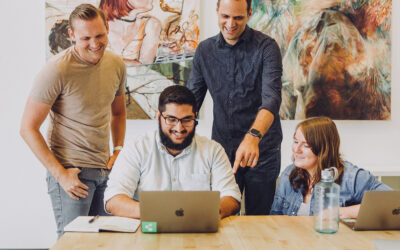As a part of our research into the evolution of hybrid-working and the rise of Poly-working, we spoke to business leaders who were able to give us a personal account of what flexible working means to them and their organisation.
Poly-working is not hybrid-working, it’s five steps further up the flexible working ladder. Poly-working is business leaders empowering their people to make their own decisions about how they want to work. It’s true flexibility around how, when and from where people work. It’s leaders gifting their people a big dose of trust and measuring results by output, not by contracted hours.
Large businesses all over the world are adopting a poly-working approach and they’re reaping the benefits. For some though, this is nothing new and they can vouch for the power of flexible working because their organisation has adopted it from day one.
Blinkist, the app which helps us consume books really fast, has always allowed its people to work flexibly. Caroline Arora, VP of People and Culture at Blinkist, explains what this looks like for the organisation.
From day one at Blinkist, we have adopted an approach where people choose their working pattern. We don’t have a rigid schedule of work as we appreciate that people produce their best work in different ways. That might be from home. That might be early mornings or late evenings and we encourage and enable people to choose what works best for them, in their teams.
We have an amazing office in Berlin where we have a beautiful kitchen (La Cantina) providing free and super healthy food for everyone as well as an open-plan, relaxed environment aiming to drive creativity and collaboration.
Our approach is ‘Berlin first, remote friendly’ and since the pandemic we have seen an increasing number of people choosing to have a more flexible and fluid hybrid working style, which we support. For example, our VP of People and Culture is based in Barcelona!
Retaining the best talent
We have always operated this way. We recognise that to attract and retain the best talent, we need to provide flexibility for people to be able to produce their best work and this isn’t always at one desk between the hours of 9-5 pm.
The pandemic encouraged people to have even more choice over their working pattern and this has created the opportunity for us to really focus on how we engage, motivate and retain everyone in this hybrid world of working. We introduced a remote playbook to support people’s understanding of hybrid working including health and safety support, communications and ideas for collaboration to further enable people.
We run engagement surveys every quarter and our most recent survey in September showed that 94% of employees felt that Blinkist enables them to balance their work and personal lives. In addition, 91% of our employees felt that we have adapted well to working remotely.
We have always seen the benefits of working flexibly and empowering people to own their roles and accountabilities. It’s part of the DNA of how we work, which started from a Holacractic operating model and now expanding with our focus on empowerment.
We believe empowered people are more engaged and productive, and we see this on our ongoing engagement surveys. This approach, which is really natural to us, enables us to attract, engage and retain the best people and create a really special, engaging community of people.
Empowering people through leadership
We started Blinkist working in a Holacratic way of working and our approach to leadership has always been more about empowering people to deliver their role however they feel fit, rather than micro-management.
Empowerment has always been a thread throughout our history and continues to be a key way of working. We do not have ‘managers’ at Blinkist, we have leaders focused more on coaching and developing individuals to learn and grow, rather than managing their day-to-day work.
In the tech space and especially in Berlin, we see hybrid working as the norm. We see an exciting trend where people who used to be office based now have the freedom and choice to decide how they want to work. So, we have people working from numerous locations rather than one desk, 5 days a week, 9-5. This brings with it some challenges specifically around workplace safety and collaboration but these are all elements of our always evolving people and culture strategy that we try to focus on, address and use to enable people.
Our whitepaper, Poly-working: The Evolution of Hybrid Working, offers an in-depth insight into how leaders are responding to the demand for more work flexibility and we provide the five interlinking areas that organisations must focus on to keep up with the curve.



